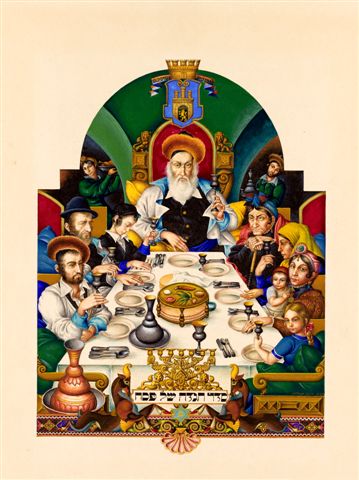
Background on the Szyk Haggadah
The current holiday season has given me a great opportunity to talk about the new edition of The Szyk Haggadah. Arthur Szyk (1894-1951) originally published his haggadah, a richly illuminated edition in gouache and watercolor, in 1940. It was printed in an edition of 250 and signed by Arthur Szyk and the historian, Cecil Roth. Roth also provided an introduction and commentary. Subsequently the haggadah was reprinted in less expensive editions in Israel, and could be found in many Jewish homes throughout the world.

New Edition
Recently, Historicana, under the direction of Irvin Ungar, created a new edition of the haggadah with permission from the collector who owns the original Haggadah artwork and Arthur Szyk’s daughter, Alexandra Szyk Bracie. This version of the Haggadah uses current technology for extremely vivid illustration photos, and includes a new translation and commentary by Byron L. Sherwin, and a companion volume, Freedom Illuminated: Understanding The Szyk Haggadah.
I had the privilege of speaking with Professor Shalom Sabar, from the Jewish Folklore and Art History faculties at Hebrew University, Jerusalem, who is one of the contributors to the companion volume, and in interviewing him, by email.
Professor Shalom Sabar
It is always a pleasure to learn from Professor Sabar and I am really pleased to be able to share his insights with you. Please note that Professor Sabar responded to my questions in Hebrew. I have translated his responses here loosely. Any defects in the translation are my fault. I am therefore, including his replies in Hebrew at the end for anyone who wishes to read them as I received them.
For more information about the haggadah or Arthur Szyk’s work in general, please see the Arthur Szyk website. I would like to thank Professor Shalom Sabar for agreeing to be interviewed and for his time as well as Irvin Ungar and Allison Chang from Historicana for their assistance in the preparation of this post and for providing images to include in this post. Please note the copyright for all images:
Original art: The Robbins Family Collection. Images courtesy Historicana, www.szyk.com.
Interview:
 1.Your companion piece is quite thorough on the history of Haggadah illumination and how Szyk uses and deviates from this tradition. Could you speak about this briefly?
1.Your companion piece is quite thorough on the history of Haggadah illumination and how Szyk uses and deviates from this tradition. Could you speak about this briefly?
Arthur Szyk was trained in the traditional sense of the word – that is, unlike other modern artists, he worked as an actual expert artist, in the manner in which medieval artists, who learned as apprentices for many years until they came to illustrate illuminated manuscripts by themselves. When they reached that stage, they were particular about each detail, and invested thought and slow technical work in each step of the progress. That is how Szyk worked– each of his pages were chocked full of details and ideas– thus, if you want to understand many elements in his pictures, also the description would become very detailed, and even like this I feel that I did not touch all the points that I wanted to relate to.
Symbols
Szyk was a symbolist in the full sense of the word. He related quite seriously to symbols and their meaning and imparted to the traditional Jewish symbols and the new symbols a higher purpose in his work.
Symbolically he placed his Jewish past in Eastern Europe and therefore it includes depictions such as Torah arks crowned with a pair of lions (or just a pair of rampant lions facing each other) Torah crowns, Jews with a thick beard dressed as traditional chasidim, traditional seder plates, kiddush cup, seven branched candelabrum, candlesticks etc. – the traditional Jewish symbols all designed according to visual tradition of Eastern European Jewry (there are no depictions of Sephardic or Mizrahi Jews!) Of the new symbols adopted Szyk mainly wanted to mention the images of Zionism or the New Jew that was widespread at the time – the pioneer, the Star of David with the word Zion, and so forth. Along with these – new symbols more unique to Szyk – “muscular Judaism” in relation to the past – Moses striking the Egyptian (Gentile) with great power, David decapitating Goliath, Samuel killing Agag and so on. Attached to all these ancient heroes he attached icons from the present – such as the shield or chariot of Jewish fighters embedded stars of David .
the traditional Jewish symbols all designed according to visual tradition of Eastern European Jewry (there are no depictions of Sephardic or Mizrahi Jews!) Of the new symbols adopted Szyk mainly wanted to mention the images of Zionism or the New Jew that was widespread at the time – the pioneer, the Star of David with the word Zion, and so forth. Along with these – new symbols more unique to Szyk – “muscular Judaism” in relation to the past – Moses striking the Egyptian (Gentile) with great power, David decapitating Goliath, Samuel killing Agag and so on. Attached to all these ancient heroes he attached icons from the present – such as the shield or chariot of Jewish fighters embedded stars of David .
3. What do you think are the main themes?
The redemption of the Jewish people in our generation, based on its rich tradition in the past and the strength to overcome [their] foes through military means.
4. What is your favorite illustration or theme in the Haggadah? How would you say that Szyk’s contemporary reality influenced his illuminations?
What is most interesting is how Szyk links the past and present in an original way and how events in his contemporary Jewish world are a direct continuation of the past. Personally I loved his idea that his ancestors in Egypt were artists – and he shows the Jewish slaves sculpting and drawing in the style of ancient Egyptian art (paintings of the pyramids, etc.). Completely fantastic (imaginary) but very original and shows the artist’s personal inclination.
 5. You talk about how the original limited edition was signed by both Arthur Szyk and Cecil Roth, who wrote the introduction and commentary to the volume. How does it feel to be the “Cecil Roth” of the new edition?
5. You talk about how the original limited edition was signed by both Arthur Szyk and Cecil Roth, who wrote the introduction and commentary to the volume. How does it feel to be the “Cecil Roth” of the new edition?
Bezalel (Cecil) Roth was an interesting researcher making inquiries about who dominated many subjects. His writing is not complete, and there are holes, but an amazing amount of diversity. In many ways he fascinates me and I feel like I follow in his footsteps in terms of interest and topics: Italian Jewry, Jewish Art, Ketubbot [Jewish marriage contracts] (he wrote the introduction to Davidovitch’s book on Ketubbot), the Jews of Sfarad, Marranos in Portugal, the Spanish Diaspora, and so on. I never got to know him personally (he died when I was a young soldier) but I went to New York specifically to meet his wife, Irene Roth, who was already very old and blind, and I sat on his chair several times in the Italian synagogue in Jerusalem. In Toronto (Beth Tzedec), I cataloged the Ketubbot that he bought in Italy and elsewhere, and wrote about many other things which he dealt with (such as symbols of the Italian Jewish family). He is therefore a type of intellectual father and I followed after him quite a bit. The Szyk Haggadah is another example although different from the others since when I went to write about it I did not even know about the relationship of Roth to this Haggadah …
שאלה 1 —
ארתור שיק היה אומן במובן המסורתי של המילה דהיינו, שלא כמו אמנים מודרניים אחרים הוא עבד כאומן מומחה ממש, בדרך בה נהגו אומנים בימי הביניים שלמדו כשוליות שנים רבות עד שהגיעו לאייר כתב יד בעצמם. וכאשר הגיעו לכך — הקפידו על כל פרט והשקיעו מחשבה ועבודה טכנית אטית בביצוע כל שלב. כך נהג שיק — כל עמוד אצלו עמוס בפרטים וברעיונות — ולפיכך אם ברצונך לעמוד על מספר רב של מרכיבים בתמונותיו התיאור גם הוא יוצא מפורט מאד, וגם ככה אני חש שלא נגעתי בכל נקודה שרציתי להתייחס אליה.
שאלה2 — 
שיק היה סימבוליסט במלוא מובן המילה. הוא התייחס ברצינות רבה לסמלים ולמשמעותם והקנה לסמלים היהודים המסורתיים והחדשים חשיבות עליונה ביצירתו. סמלי העבר היהודי שלו נטועים במקורותיו במזרח אירופה ולפיכך כוללים דימויים כמו ארונות קודש מוכתרים בצמד אריות(או רק צמד האריות המזנקים זה מול זה) כתרי תורה, יהודים בעלי זקן עבות לבושים בבגד חסידי מסורתי, קערת ליל סדר, גביע לקידוש, מנורת שבעת קנים ופמוטים וכו’ — סמלים של היהודי המסורתי המעוצבים כולם על פי המסורת החזותית של יהדות מזרח אירופה (אין דימויים של יהדות ספרד או המזרח!) .
מבין הסמלים החדשים שאימץ שיק ניתן להזכיר בעיקר את הדימויים של הציונות או היהודי החדש שרווחו בזמנו– החלוץ, מגן דוד עם המילה ציון וכן הלאה. לצד אלה– סמלים חדשים יחודיים יותר לשיק– “יהדות השרירים” ביחס לעבר– משה מכה את המצרי(הגוי) בכח רב, דוד העורף את ראש גלית, שמואל ההורג את אגג, וכן הלאה. לכל הגיבורים העתיקים מוצמדים סמלים מההווה– כגון המגן או המרכבה של לוחמי ישראל ובהם משובצים מגיני דוד..
שאלה 3—
גאולת העם היהודי בדורנו על סמך המסורת העשירה שלו בעבר וכוחו להתגבר על אויביו באמצעים צבאיים
שאלה 4 —
המעניין ביותר זה כיצד שיק מקשר בין עבר והווה בדרך מקורית וכיצד בשבילו האירועים ביהדות העולם של זמנו הם המשך ישיר לעבר. באופן אישי אהבתי מאד את הרעיון שלו שאבות אבותיו במצרים היו אמנים — והוא מראה את העבדים העבריים מפסלים ומציירים בסגנון האמנות המצרית העתיקה (ציורי הפירמידות, וכו’). פנטסטי (דמיוני) לחלוטין .אך מאד מקורי ומראה על נטייתו האישית של האמן
שאלה 5– 
בצלאל (ססיל) רות היה חוקר מעניין אשר שלט בנושאים רבים .הכתיבה שלו לא מושלמת ויש בה חורים אך מדהימה בכמותה וברבגוניותה .מבחינה רבות הוא מרתק אותי ואני מרגיש שאני הולך בעקבותיו מבחינת העניין והנושאים:יהדות איטליה, אמנות יהודית, כתובות (הוא כתב את המבוא לספר הכתובה של דבידוביץ), יהדות ספרד, האנוסים בפורטוגל ובתפוצה הספרדית, וכן הלאה. לא זכיתי להכירו אישית (נפטר עוד כשהייתי חייל צעיר) אך נסעתי במיוחד לניו יורק לפגוש את רעייתו, איירין רות, שהייתה כבר מאד זקנה ועיוורת, וכן ישבתי פעמים אחדות על כסאו בבית הכנסת האיטלקי בירושלים. בטורונטו (בית צדק) קטלגתי את הכתובות שרכש באיטליה ובמקומות אחרים, וכתבתי על הרבה פריטים אחרים בהם עסק (למשל סמלי משפחה של יהודי איטליה).לפיכך הוא מעין אב רוחני והלכתי הרבה בעקבותיו. ההגדה של שיק היא עוד דוגמא אם כי שונה מהפריטים האחרים וכאשר נגשתי לכתוב עליה לא ידעתי אפילו על הקשר של רות’ להגדה זו…
Page captions for the Szyk Haggadah based on the order in which they appear:


This Haggadah is beautiful !
Thank you for this article 🙂
am looking FW for more !
Great article!
thanks!
[…] on our site, such as Rav Mitch Hefetz’s Haggadah, the Ethiopian Haggadah, or the artistic Szyk Haggadah. These can serve as a starting point for ideas. There are also some great books about the history […]